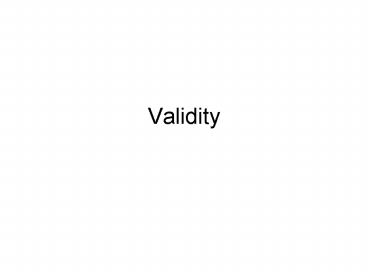Validity PowerPoint PPT Presentation
Title: Validity
1
Validity
2
True experiments
- some type of intervention or treatment
implemented - high degree of control over experimental
conditions systematic manipulation of IV choice
of DV and assignment of participants - characterized by appropriate comparison (eg 2
groups exactly alike except for variable of
interest)
3
Independent Variable
- MANIPULATED
- a) situational - features in the environment
- b) task type of task performed
- c) instructional type of instructions given
- control vs experimental groups
4
- NOT MANIPULATED
- Subject variable existing differences of
participants - - cannot infer causality because cannot
manipulate - control vs comparison group
5
Dependent Variable (measured)
- Uses operational definition
- The usefulness of the experiment depends on what
is measured
6
Validity
- Methodological soundness
- a valid test measures what it is supposed to
measure - a valid research design tests what it is supposed
to test
7
Null Hypothesis
- nothing happened
- if reject HO then accept H1 alternative or .H2
H3 H4 confounding variable hypotheses - Cannot be sure significant change in DV due to IV
could be due to confounds - Rejecting the null hypothesis is necessary but
not sufficient to draw causal inference.
8
Experimental validity
- External validity
- Ability to generalize findings beyond sample
- Internal Validity
- the demonstration of causality
- was the IV or a confound the cause
9
- Statistical validity
- Statistical conclusions reasonable
10
Threats to validity
- measures of DV unreliable
- violation of assumptions underlying statistical
test. (distorts p value and makes decision
undependable) - confounds
11
- The confounding variable is not directly tested
- Each confounding hypothesis ruled out by design.
12
- A variable can only confound the results if
- It has an impact on DV scores
- Groups or conditions differ on the variable
13
8 confounds threaten internal validity
- 1) history - all subjects have the same history
of experiences while in the experiment - 2) maturation participants change as a function
of time - 3) testing taking a test can influence
subsequent tests cannot separate effect of
testing from effect of treatment - 4) instrumentation change with subjects
(fatigue,bias..) - 5) regression effects if select extreme scores
then change in score may be treatment or
regression effects
14
- 6) subject attrition (mortality) something
different about subjects that stay. - 7) selection something different about subjects
in groups because of lack of control of
assignment - 8) additive effects with selection confounds
interact with selection effect - selection-maturation
- selection history
- selection-instrumentation
15
- Confounds for both true and quasi experiments
- 1) contamination communication of information
about experiment between groups - resentments, rivalry, diffusion of treatment.
- 2) if sample not good representation of
population little external validity - 3) Hawthorne effect - subjects behavior changes
because they know someone is interested/watching
them,..
16
Langer and Rodin 1976
- Environmental changes associated with old age
contribute to feelings of self-esteem. - Quasi-experimental
- Setting nursing home
- IV type of information given to residents
- 1) stressed resident responsibility
- 2) stressed staff responsibility
17
- Residents already assigned to floors on basis of
availability some had been there a long time - Different floors got different IV level
- Floors chosen for similarity in health age SES
- DV
- questionnaires rating how much control over
lives etc. given 1 week before and 3 weeks after - Staff rated on sociability
- Jellybean contest
18
- Selection effect? 2 floors did not differ on
pretest - Selection-maturational ? same population for
age health etc - Selection history? Local effects quite possible
- Selection-instrumentation no obvious selection
effect and no ceiling floor effects so unlikely - Regression one group not more extreme to start
- Observer bias- staff unaware
- Contamination tend to stay on own floor
- Hawthorne no difference in amount of attention
19
- Best time to rule out confounds is in design
phase - Confounding Variable Hypothesis
- Observed differences might be due to extraneous
factors that have systematic effects on the
dependent measure
20
Construct Validity
- how well results support theory or construct
- is theory best available explanation of result
- clear definitions help
- chicken and egg problem
- eg math ability and taking classes (learned or
innate)
21
Characteristics of Research Hypotheses
- declarative sentence
- brief and clear
- identifies at least 2 variables
- states an expected (predicted) relationship
between at least one variable and at least one
other variable - states nature of relationship
- states direction of relationship
- the predicted relationship is empirically testable

